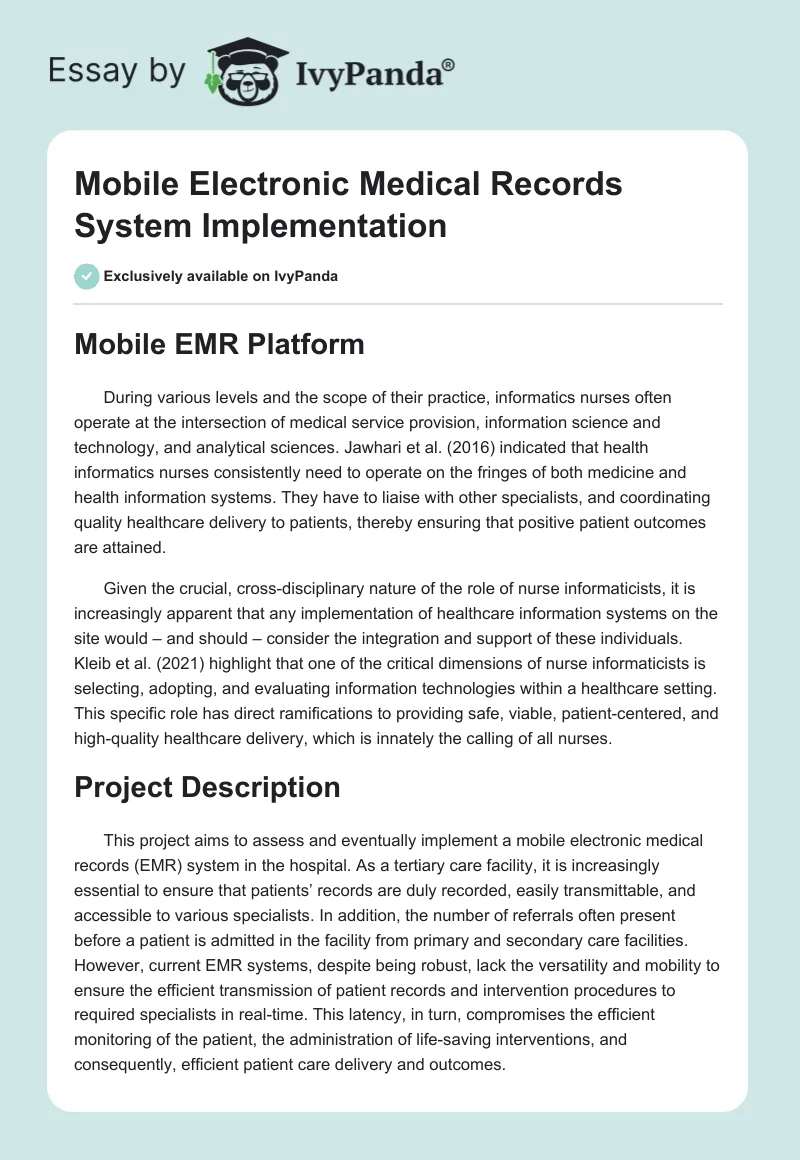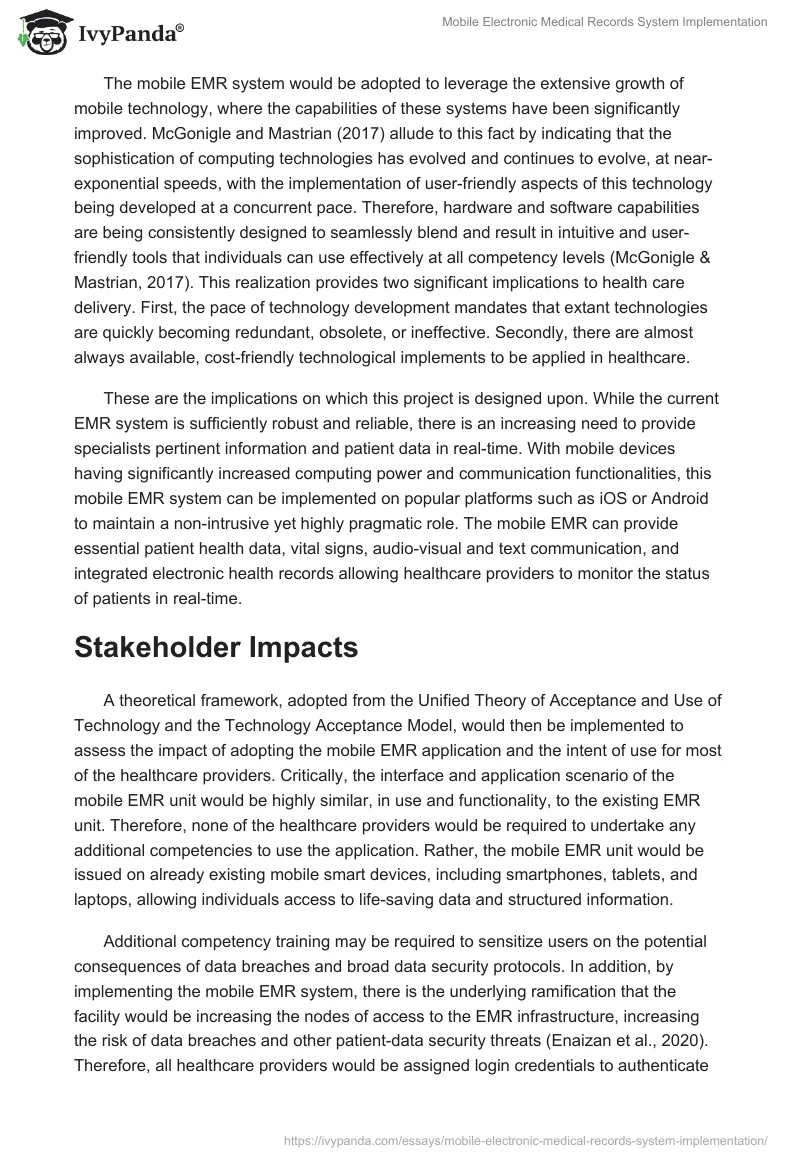Mobile EMR Platform
During various levels and the scope of their practice, informatics nurses often operate at the intersection of medical service provision, information science and technology, and analytical sciences. Jawhari et al. (2016) indicated that health informatics nurses consistently need to operate on the fringes of both medicine and health information systems. They have to liaise with other specialists, and coordinating quality healthcare delivery to patients, thereby ensuring that positive patient outcomes are attained.
Given the crucial, cross-disciplinary nature of the role of nurse informaticists, it is increasingly apparent that any implementation of healthcare information systems on the site would – and should – consider the integration and support of these individuals. Kleib et al. (2021) highlight that one of the critical dimensions of nurse informaticists is selecting, adopting, and evaluating information technologies within a healthcare setting. This specific role has direct ramifications to providing safe, viable, patient-centered, and high-quality healthcare delivery, which is innately the calling of all nurses.
Project Description
This project aims to assess and eventually implement a mobile electronic medical records (EMR) system in the hospital. As a tertiary care facility, it is increasingly essential to ensure that patients’ records are duly recorded, easily transmittable, and accessible to various specialists. In addition, the number of referrals often present before a patient is admitted in the facility from primary and secondary care facilities. However, current EMR systems, despite being robust, lack the versatility and mobility to ensure the efficient transmission of patient records and intervention procedures to required specialists in real-time. This latency, in turn, compromises the efficient monitoring of the patient, the administration of life-saving interventions, and consequently, efficient patient care delivery and outcomes.
The mobile EMR system would be adopted to leverage the extensive growth of mobile technology, where the capabilities of these systems have been significantly improved. McGonigle and Mastrian (2017) allude to this fact by indicating that the sophistication of computing technologies has evolved and continues to evolve, at near-exponential speeds, with the implementation of user-friendly aspects of this technology being developed at a concurrent pace. Therefore, hardware and software capabilities are being consistently designed to seamlessly blend and result in intuitive and user-friendly tools that individuals can use effectively at all competency levels (McGonigle & Mastrian, 2017). This realization provides two significant implications to health care delivery. First, the pace of technology development mandates that extant technologies are quickly becoming redundant, obsolete, or ineffective. Secondly, there are almost always available, cost-friendly technological implements to be applied in healthcare.
These are the implications on which this project is designed upon. While the current EMR system is sufficiently robust and reliable, there is an increasing need to provide specialists pertinent information and patient data in real-time. With mobile devices having significantly increased computing power and communication functionalities, this mobile EMR system can be implemented on popular platforms such as iOS or Android to maintain a non-intrusive yet highly pragmatic role. The mobile EMR can provide essential patient health data, vital signs, audio-visual and text communication, and integrated electronic health records allowing healthcare providers to monitor the status of patients in real-time.
Stakeholder Impacts
A theoretical framework, adopted from the Unified Theory of Acceptance and Use of Technology and the Technology Acceptance Model, would then be implemented to assess the impact of adopting the mobile EMR application and the intent of use for most of the healthcare providers. Critically, the interface and application scenario of the mobile EMR unit would be highly similar, in use and functionality, to the existing EMR unit. Therefore, none of the healthcare providers would be required to undertake any additional competencies to use the application. Rather, the mobile EMR unit would be issued on already existing mobile smart devices, including smartphones, tablets, and laptops, allowing individuals access to life-saving data and structured information.
Additional competency training may be required to sensitize users on the potential consequences of data breaches and broad data security protocols. In addition, by implementing the mobile EMR system, there is the underlying ramification that the facility would be increasing the nodes of access to the EMR infrastructure, increasing the risk of data breaches and other patient-data security threats (Enaizan et al., 2020). Therefore, all healthcare providers would be assigned login credentials to authenticate themselves each time they use the platform, using logs routinely reviewed to flag any suspicious activity on various accounts (Xu, 2019). While this may result into additional roles assigned to the facility’s EMR system administrators, the impact on healthcare delivery would be worth the hassle.
The cost of implementation of the mobile EMR platform is also relatively manageable. Existing service providers and contractors are providing robust mobile EMR offerings that can be implemented in various facilities, with the option of continued support and updates at a considerably low cost. Parasarathy et al. (2018) indicate that more often than not, the cost of implementation of an EMR system within a healthcare facility is worth it – and even legally mandated in certain jurisdictions –, considering the increasingly integral role that these technologies play in the provision of quality, consistent healthcare delivery. Further, with the consistent proliferation of technology development, and the high competition in the domain, good technology is becoming relatively cost-effective, while cost-effective technology is becoming good.
Patient Outcomes and Patient Care Efficiencies
Hospitals, including this particular facility, have been increasingly using EMR systems. This is due to the already well-understood impact of these technologies in providing quality healthcare services to patients. Healthcare delivery is optimized through delineating access to patient data and vital statistics, allowing easier access to structured information, and improving overall patient safety through decision support and better access to information by healthcare providers (Dagliati et al., 2021). However, the current EMR system is privy to a common pitfall associated with technology development and computerization. Essentially, dematerialization is a significant advantage of computer technology; however, the current iteration of EMR, which leverages this technology, often decreases mobility by healthcare providers as they are tethered to computers in many clinical settings.
For the best patient outcomes and patient care efficiencies, it is paramount that the medical environment is characterized by free usability and mobility. This would then allow healthcare professionals to provide quality patient care in various situations and application scenarios. Since implementing the EMR in this facility, this movement may have been significantly hindered by reliance on stationary computers. The mobile EMR essentially transforms these access nodes to the EMR infrastructure from immobile computer platforms to mobile technologies, making smartphones, tablets, and laptops personal mobile assistants. This will allow healthcare professionals to gain access to critical patient data conveniently and quickly.
Implementation Resources
There will be minimal disruption to existing facility resources, both capital and human resources, with the implementation of the mobile EMR system. This is because the application itself would be secured from a third-party, reputable provider over a Software-as-a-Service (SaaS) capacity to ensure after-sales support and consistent updates, and quality control. The nurse informaticist would be mandated to ensure the seamless integration of the mobile platform with the current EMR system, which would not be significantly altered. Further, these individuals would be required to ensure efficient coordination and installation of the mobile EMR and the required attribute-based security infrastructure on the necessary mobile devices. Overall, implementing the mobile EMR platform in this facility provides an opportunity to leverage current technologies for the vast improvement of patient outcomes and care delivery.
References
Dagliati, A., Malovini, A., Tibollo, V., & Bellazzi, R. (2021). Health informatics and EHR to support clinical research in the COVID-19 pandemic: an overview.Briefings in bioinformatics, 22(2), 812-822. Web.
Enaizan, O., Eneizan, B., Almaaitah, M., Al-Radaideh, A. T., & Saleh, A. M. (2020). Effects of privacy and security on the acceptance and usage of EMR: the mediating role of trust on the basis of multiple perspectives. Informatics in Medicine Unlocked, 21(10), 795-822. Web.
Jawhari, B., Ludwick, D., Keenan, L., Zakus, D., & Hayward, R. (2016). Benefits and challenges of EMR implementations in low resource settings: a state-of-the-art review. BMC Medical Informatics and Decision Making, 16(1), pp. 1-12. Web.
Kleib, M., Chauvette, A., Furlong, K., Nagle, L., Slater, L., & McCloskey, R. (2021). Approaches for defining and assessing nursing informatics competencies: a scoping review. JBI Evidence Synthesis, 19(4), 794-841.
McGonigle, D., & Mastrian, K. (2017). Nursing informatics and the foundation of knowledge (4th ed.). Burlington, MA: Jones & Bartlett Publishers.
Parthasarathy, R., Steinbach, T., Knight, J., & Knight, L. (2018). Framework to enhance nurses’ use of EMR.Hospital topics, 96(3), 85-93. Web.
Xu, Z. (2019). An empirical study of patients’ privacy concerns for health informatics as a service. Technological Forecasting and Social Change, 143, 297-306. Web.


